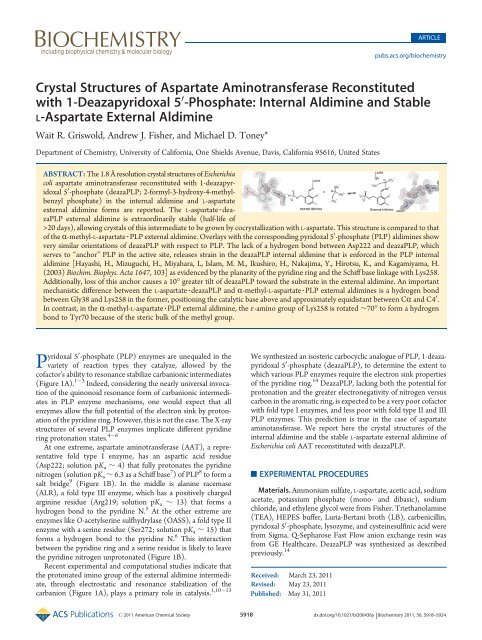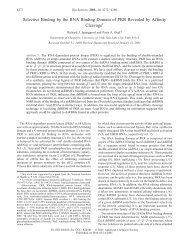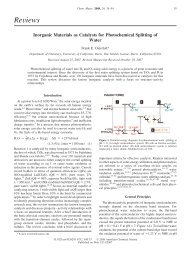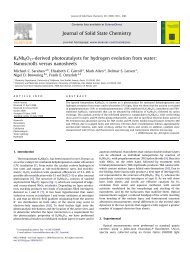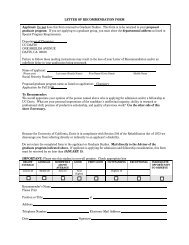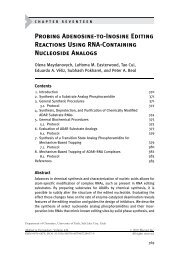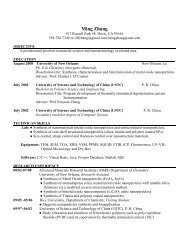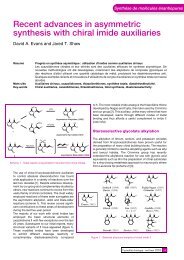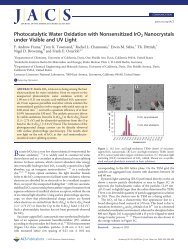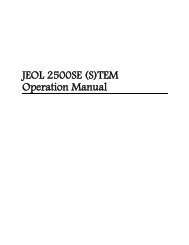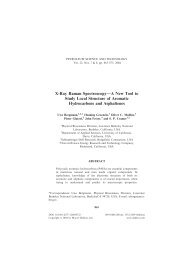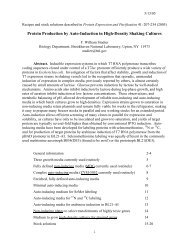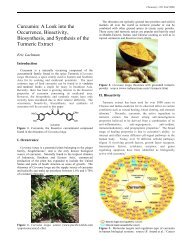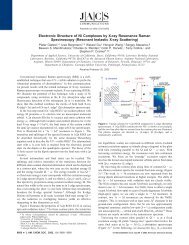Crystal Structures of Aspartate Aminotransferase Reconstituted with ...
Crystal Structures of Aspartate Aminotransferase Reconstituted with ...
Crystal Structures of Aspartate Aminotransferase Reconstituted with ...
You also want an ePaper? Increase the reach of your titles
YUMPU automatically turns print PDFs into web optimized ePapers that Google loves.
Received: March 23, 2011<br />
Revised: May 23, 2011<br />
Published: May 31, 2011<br />
ARTICLE<br />
pubs.acs.org/biochemistry<br />
<strong>Crystal</strong> <strong>Structures</strong> <strong>of</strong> <strong>Aspartate</strong> <strong>Aminotransferase</strong> <strong>Reconstituted</strong><br />
<strong>with</strong> 1-Deazapyridoxal 5 0 -Phosphate: Internal Aldimine and Stable<br />
L-<strong>Aspartate</strong> External Aldimine<br />
Wait R. Griswold, Andrew J. Fisher, and Michael D. Toney*<br />
Department <strong>of</strong> Chemistry, University <strong>of</strong> California, One Shields Avenue, Davis, California 95616, United States<br />
ABSTRACT: The 1.8 Å resolution crystal structures <strong>of</strong> Escherichia<br />
coli aspartate aminotransferase reconstituted <strong>with</strong> 1-deazapyridoxal<br />
5 0 -phosphate (deazaPLP; 2-formyl-3-hydroxy-4-methylbenzyl<br />
phosphate) in the internal aldimine and L-aspartate<br />
external aldimine forms are reported. The L-aspartate 3 deazaPLP<br />
external aldimine is extraordinarily stable (half-life <strong>of</strong><br />
>20 days), allowing crystals <strong>of</strong> this intermediate to be grown by cocrystallization <strong>with</strong> L-aspartate. This structure is compared to that<br />
<strong>of</strong> the R-methyl-L-aspartate 3 PLP external aldimine. Overlays <strong>with</strong> the corresponding pyridoxal 5 0 -phosphate (PLP) aldimines show<br />
very similar orientations <strong>of</strong> deazaPLP <strong>with</strong> respect to PLP. The lack <strong>of</strong> a hydrogen bond between Asp222 and deazaPLP, which<br />
serves to “anchor” PLP in the active site, releases strain in the deazaPLP internal aldimine that is enforced in the PLP internal<br />
aldimine [Hayashi, H., Mizuguchi, H., Miyahara, I., Islam, M. M., Ikushiro, H., Nakajima, Y., Hirotsu, K., and Kagamiyama, H.<br />
(2003) Biochim. Biophys. Acta 1647, 103] as evidenced by the planarity <strong>of</strong> the pyridine ring and the Schiff base linkage <strong>with</strong> Lys258.<br />
Additionally, loss <strong>of</strong> this anchor causes a 10° greater tilt <strong>of</strong> deazaPLP toward the substrate in the external aldimine. An important<br />
mechanistic difference between the L-aspartate 3 deazaPLP and R-methyl-L-aspartate 3 PLP external aldimines is a hydrogen bond<br />
between Gly38 and Lys258 in the former, positioning the catalytic base above and approximately equidistant between CR and C4 0 .<br />
In contrast, in the R-methyl-L-aspartate 3 PLP external aldimine, the ε-amino group <strong>of</strong> Lys258 is rotated ∼70° to form a hydrogen<br />
bond to Tyr70 because <strong>of</strong> the steric bulk <strong>of</strong> the methyl group.<br />
Pyridoxal 50-phosphate (PLP) enzymes are unequaled in the<br />
variety <strong>of</strong> reaction types they catalyze, allowed by the<br />
c<strong>of</strong>actor's ability to resonance stabilize carbanionic intermediates<br />
(Figure 1A). 1 3 Indeed, considering the nearly universal invocation<br />
<strong>of</strong> the quinonoid resonance form <strong>of</strong> carbanionic intermediates<br />
in PLP enzyme mechanisms, one would expect that all<br />
enzymes allow the full potential <strong>of</strong> the electron sink by protonation<br />
<strong>of</strong> the pyridine ring. However, this is not the case. The X-ray<br />
structures <strong>of</strong> several PLP enzymes implicate different pyridine<br />
4 6<br />
ring protonation states.<br />
At one extreme, aspartate aminotransferase (AAT), a representative<br />
fold type I enzyme, has an aspartic acid residue<br />
(Asp222; solution pKa ∼ 4) that fully protonates the pyridine<br />
nitrogen (solution pKa ∼ 6.3 as a Schiff base 7 ) <strong>of</strong> PLP 8 to form a<br />
salt bridge 9 (Figure 1B). In the middle is alanine racemase<br />
(ALR), a fold type III enzyme, which has a positively charged<br />
arginine residue (Arg219; solution pKa ∼ 13) that forms a<br />
hydrogen bond to the pyridine N. 5 At the other extreme are<br />
enzymes like O-acetylserine sulfhydrylase (OASS), a fold type II<br />
enzyme <strong>with</strong> a serine residue (Ser272; solution pKa ∼ 15) that<br />
forms a hydrogen bond to the pyridine N. 6 This interaction<br />
between the pyridine ring and a serine residue is likely to leave<br />
the pyridine nitrogen unprotonated (Figure 1B).<br />
Recent experimental and computational studies indicate that<br />
the protonated imino group <strong>of</strong> the external aldimine intermediate,<br />
through electrostatic and resonance stabilization <strong>of</strong> the<br />
1,10 13<br />
carbanion (Figure 1A), plays a primary role in catalysis.<br />
We synthesized an isosteric carbocyclic analogue <strong>of</strong> PLP, 1-deazapyridoxal<br />
5 0 -phosphate (deazaPLP), to determine the extent to<br />
which various PLP enzymes require the electron sink properties<br />
<strong>of</strong> the pyridine ring. 14 DeazaPLP, lacking both the potential for<br />
protonation and the greater electronegativity <strong>of</strong> nitrogen versus<br />
carbon in the aromatic ring, is expected to be a very poor c<strong>of</strong>actor<br />
<strong>with</strong> fold type I enzymes, and less poor <strong>with</strong> fold type II and III<br />
PLP enzymes. This prediction is true in the case <strong>of</strong> aspartate<br />
aminotansferase. We report here the crystal structures <strong>of</strong> the<br />
internal aldimine and the stable L-aspartate external aldimine <strong>of</strong><br />
Escherichia coli AAT reconstituted <strong>with</strong> deazaPLP.<br />
’ EXPERIMENTAL PROCEDURES<br />
Materials. Ammonium sulfate, L-aspartate, acetic acid, sodium<br />
acetate, potassium phosphate (mono- and dibasic), sodium<br />
chloride, and ethylene glycol were from Fisher. Triethanolamine<br />
(TEA), HEPES buffer, Luria-Bertani broth (LB), carbenicillin,<br />
pyridoxal 5 0 -phosphate, lysozyme, and cysteinesulfinic acid were<br />
from Sigma. Q-Sepharose Fast Flow anion exchange resin was<br />
from GE Healthcare. DeazaPLP was synthesized as described<br />
previously. 14<br />
r 2011 American Chemical Society 5918 dx.doi.org/10.1021/bi200436y | Biochemistry 2011, 50, 5918–5924
Biochemistry ARTICLE<br />
Figure 1. (A) Formation and stabilization <strong>of</strong> the carbanionic intermediate <strong>with</strong> a protonated pyridine nitrogen. The external aldimine is a common<br />
intermediate in all PLP-catalyzed reactions. (B) The protonation state <strong>of</strong> the pyridine nitrogen <strong>of</strong> PLP enzymes is expected to vary <strong>with</strong> the acidity <strong>of</strong> the<br />
amino acid side chain interacting <strong>with</strong> it. AAT is expected to fully protonate N1 <strong>of</strong> PLP via Asp222. Alanine racemase and O-acetylserine sulfhydrylase<br />
likely maintain N1 in a neutral state through interaction <strong>with</strong> Arg219 and Ser272, respectively.<br />
Enzyme. A pUC119 plasmid containing the gene encoding<br />
E. coli AAT 15 was transformed into E. coli MG204 cells by<br />
electroporation. Transformed cells, grown on LB agar plates<br />
containing 100 μg/mL carbenicillin, were transferred to 2YT<br />
medium containing 100 μg/mL carbenicillin and grown <strong>with</strong><br />
shaking at 225 rpm for 36 h at 37 °C. Cells were collected by<br />
centrifugation at 5000g for 30 min at 4 °C and were resuspended<br />
in lysis buffer [20 mM potassium phosphate buffer (pH 7.0),<br />
200 μM PLP, and 0.5 mg/mL lysozyme]. The mixture was stirred<br />
on ice for 30 min then subjected to sonication, which consisted <strong>of</strong><br />
five 1 min pulses performed for each 10 g <strong>of</strong> cell paste. The lysed<br />
cells were centrifuged at 18000g and 4 °C for 1 h. Sodium acetate<br />
was added to the supernatant to a final concentration <strong>of</strong> 20 mM<br />
and the pH lowered to 4.9 via the addition <strong>of</strong> dilute acetic acid.<br />
The resulting solution was cooled on ice for 10 min followed by<br />
centrifugation at 18000g for 30 min at 4 °C. The pellet, containing<br />
precipitated protein, was discarded, and the supernatant was<br />
dialyzed against three changes <strong>of</strong> 20 mM sodium acetate (pH<br />
4.9) and 20 μM PLP. The dialysate was centrifuged at 12000g for<br />
30 min at 4 °C, loaded at a rate <strong>of</strong> 2 mL/min onto a 50 mL<br />
Q-Sepharose Fast Flow anion exchange column, and washed<br />
<strong>with</strong> 10 bed volumes <strong>of</strong> wash buffer [20 mM sodium acetate (pH<br />
4.9) and 20 μM PLP] at a rate <strong>of</strong> 4 mL/min. This was followed by<br />
a linear gradient elution from 100% wash buffer to 100% elution<br />
buffer [20 mM sodium acetate (pH 4.9), 300 mM NaCl, and<br />
20 μM PLP] over 1 L at a flow rate <strong>of</strong> 2 mL/min. Fractions<br />
containing AAT, as judged by the absorbance at 430 nm, were<br />
analyzed by sodium dodecyl sulfate polyacrylamide gel electrophoresis<br />
to assess purity. Pure fractions were combined, dialyzed<br />
against three changes <strong>of</strong> 20 mM HEPES (pH 7.5), and concentrated<br />
to 10 mg/mL. Aliquoted samples were flash-frozen in<br />
liquid nitrogen and stored at 80 °C. The apoenzyme was<br />
prepared as previously described 16 and reconstituted by overnight<br />
incubation <strong>with</strong> a 10-fold excess <strong>of</strong> deazaPLP. Dialysis<br />
was performed against 50 mm TEA (pH 7.5), 100 mM KCl,<br />
and 2 mM DTT to achieve a final free deazaPLP concentration<br />
<strong>of</strong> ∼10 μM followed by concentration <strong>of</strong> the enzyme to<br />
∼15 20 mg/mL.<br />
<strong>Crystal</strong>lization and Data Collection. <strong>Crystal</strong>s were obtained<br />
by the hanging drop method. A 2 μL drop <strong>of</strong> protein solution<br />
(15 20 mg/mL) [50 mM TEA (pH 7.5), 100 mM KCl, 2 mM<br />
DTT, and 10 μM deazaPLP] was mixed <strong>with</strong> 2 μL <strong>of</strong> reservoir<br />
buffer containing 53 60% saturated ammonium sulfate and<br />
50 mM TEA (pH 7.5). L-<strong>Aspartate</strong> was added to a final<br />
concentration <strong>of</strong> 50 mM to the hanging drop to obtain the<br />
external aldimine. Large yellow crystals formed under the<br />
5919 dx.doi.org/10.1021/bi200436y |Biochemistry 2011, 50, 5918–5924
Biochemistry ARTICLE<br />
Table 1. Data Collection and Refinement Statistics for Deaza-<br />
PLP AAT <strong>Structures</strong> a<br />
internal aldimine<br />
L-aspartate<br />
external aldimine<br />
unit cell dimensions<br />
a, b, c (Å)<br />
154.68, 84.75, 79.15 154.83, 83.78, 77.80<br />
space group C2221 C2221 no. <strong>of</strong> monomers per<br />
asymmetric unit<br />
1 1<br />
resolution range (Å) 77.3 1.80 (1.84 1.80) 38.9 1.80 (1.86 1.80)<br />
Rsym b (%) 5.6 (42.8) 5.9 (39.6)<br />
ÆIæ/σÆIæ 10.7 (2.2) 17.5 (2.8)<br />
no. <strong>of</strong> reflections 167956 (11977) 160082 (15291)<br />
no. <strong>of</strong> unique reflections 48807 (3603) 46701 (4606)<br />
redundancy 3.4 (3.3) 3.4 (3.3)<br />
completeness (%) 99.1 (99.7) 98.2 (97.5)<br />
c<br />
Rfactor (%) 15.15 14.79<br />
Rfree d (%) 18.80 17.90<br />
no. <strong>of</strong> protein atoms 3151 3206<br />
no. <strong>of</strong> c<strong>of</strong>actor atoms 15 24<br />
no. <strong>of</strong> water atoms 396 323<br />
no. <strong>of</strong> sulfate atoms 25 40<br />
no. <strong>of</strong> ethylene<br />
glycol atoms<br />
16 16<br />
no. <strong>of</strong> chloride atoms<br />
root-mean-square<br />
deviation from<br />
ideality<br />
0 1<br />
bond distances (Å) 0.017 0.016<br />
bond angles (deg)<br />
average isotropic B factor<br />
1.486 1.518<br />
protein 33 37<br />
solvent 43 47<br />
a<br />
Numbers in parentheses represent data for the highest-resolution shell.<br />
b<br />
Rmerge =(∑h∑i|Ih Ihi|/∑h∑iIhi], where Ih is the mean <strong>of</strong> Ihi observations<br />
<strong>of</strong> reflection h. c Rfactor = ∑||Fo| |Fc||/∑|Fo| 100 for 95% <strong>of</strong> the<br />
recorded data. d Rfree = ∑||Fo| |Fc||/∑|Fo| 100 for 5% <strong>of</strong> the<br />
recorded data.<br />
54 56% saturated ammonium sulfate conditions <strong>with</strong>in 3 5<br />
days for the internal aldimine and <strong>with</strong> 52% saturated ammonium<br />
sulfate for the external aldimine. Larger multicrystal aggregates<br />
were broken up, mounted, and stored in liquid nitrogen using<br />
23% ethylene glycol in mother liquor for the cryoprotectant.<br />
Data were collected on beamline 9-2 at the Stanford Synchrotron<br />
Radiation Lightsource. Diffraction data were processed <strong>with</strong><br />
MOSFLM and scaled <strong>with</strong> SCALA. 17 <strong>Crystal</strong> parameters and<br />
data collection statistics are listed in Table 1.<br />
Structure Determination and Refinement. Both the internal<br />
and external aldimine structures were determined by molecular<br />
replacement using E. coli AAT [Protein Data Bank (PDB)<br />
entry 1ASE] as the search model. 18 Model building was performed<br />
<strong>with</strong> COOT. 19 Refinement, including TLS parametrization,<br />
employed REFMAC 20 first and then Phenix. 21 Both the<br />
internal aldimine (as a modified Lys258 residue, 3QN) and the<br />
external aldimine (3QP, built <strong>with</strong> Sketcher 17 ) were added after<br />
initial refinement <strong>of</strong> the protein structure. Water, sulfate, and<br />
ethylene glycol molecules were added using COOT. The final<br />
Figure 2. (A) 2Fo Fc electron density map (1σ) <strong>of</strong> the deazaPLP<br />
internal aldimine. (B) Overlay <strong>of</strong> the active site <strong>of</strong> the deazaPLP (gray)<br />
and PLP (yellow) active sites (PDB entry 1AJR).<br />
refinement in Phenix included hydrogens. Individual isotropic B<br />
factors were refined for all atoms, resulting in decreased Rfactor<br />
and Rfree parameters. Group occupancies were refined for<br />
residues <strong>with</strong> multiple conformations, as well as waters, sulfates,<br />
and ethylene glycols. The TLS refinement used three groups <strong>of</strong><br />
residues (13 54, 55 330, and 331 408) determined from the<br />
TLS Motion Determination server (http://skuld.bmsc.washington.edu/∼tlsmd/).<br />
Refinement statistics for the final structures<br />
are listed in Table 1. All structure superimpositions and images<br />
were made using CCP4Molecular Graphics. 22 The coordinates<br />
for wild-type AAT reconstituted <strong>with</strong> deazaPLP have been<br />
deposited in the Protein Data Bank (entry 3QN6 for the internal<br />
aldimine and entry 3QPG for the L-aspartate external aldimine).<br />
’ RESULTS<br />
Overall Structure <strong>of</strong> the DeazaPLP Internal Aldimine.<br />
<strong>Aspartate</strong> aminotranferase exists in solution as an R2 dimer <strong>with</strong><br />
each subunit composed <strong>of</strong> 396 amino acid residues. In the C2221<br />
space group obtained here, the asymmetric unit consists <strong>of</strong> one<br />
5920 dx.doi.org/10.1021/bi200436y |Biochemistry 2011, 50, 5918–5924
Biochemistry ARTICLE<br />
Figure 3. UV vis spectra <strong>of</strong> apo AAT (—) AAT 3 PLP, ( ), and<br />
AAT 3 deazaPLP (999). Conditions: 100 mM TEA, pH 8.0, and<br />
∼5 μM enzyme.<br />
monomer <strong>of</strong> this dimer. Ramachandran plots show all residues<br />
<strong>with</strong>in acceptable regions except Tyr161, Ser296, and Asn347,<br />
which are marginal but were confirmed to have the correct<br />
conformation. Superimposition <strong>of</strong> the final refined internal<br />
aldimine model <strong>with</strong> the coordinates (PDB entry 1ASE) <strong>of</strong> the<br />
structure used for phasing 18 resulted in a root-mean-square<br />
deviation (rmsd) <strong>of</strong> 1.0 Å for 392 equivalent R-carbons. The<br />
greatest difference was found in residues 1 46 <strong>with</strong> displacements<br />
<strong>of</strong> 1.2 3.7 Å. Other displacements greater than 2 Å<br />
include those <strong>of</strong> Gly345, Asn347, Glu375, and Glu376. Each<br />
subunit consists <strong>of</strong> two domains: a small domain (residues 1 48<br />
and 326 396) and a large, PLP-binding domain. 23 The domains<br />
consist <strong>of</strong> the following secondary structures: two pairs <strong>of</strong> βstrands<br />
(one parallel and the other antiparallel) and five R-helices<br />
in the small domain and 12 - helices, one <strong>of</strong> which is shared <strong>with</strong><br />
the small domain, and a central seven-strand β-sheet, <strong>with</strong> one<br />
strand antiparallel, in the large domain. 23 The subunit interface,<br />
as previously detailed, 23 is required for formation <strong>of</strong> the two<br />
active sites, each one binding one deazaPLP c<strong>of</strong>actor and<br />
consisting <strong>of</strong> residues from each subunit.<br />
Active Site <strong>of</strong> the DeazaPLP Internal Aldimine. Panels A<br />
and B <strong>of</strong> Figure 2 show the 2Fo Fc electron density map <strong>of</strong> the<br />
active site and its overlay <strong>with</strong> the PLP internal aldimine,<br />
respectively (PDB entry 1AJR, a pig cytosolic structure at low<br />
pH). The internal aldimine is formed between the C4 0 aldehyde<br />
<strong>of</strong> the deazaPLP c<strong>of</strong>actor and the ε-amino group <strong>of</strong> Lys258 (see<br />
Figure 1A for numbering). The Schiff base is nearly coplanar to<br />
the pyridine ring, <strong>with</strong> a torsion angle <strong>of</strong> ∼7°. It displays maximal<br />
absorbance at ∼420 nm in solution, 14 consistent <strong>with</strong> a protonated<br />
aldimine 24 (Figure 3). The O3 0 phenol <strong>of</strong> deazaPLP forms<br />
a hydrogen bond to both Tyr225 and the side chain amide<br />
nitrogen <strong>of</strong> Asn194. The phosphate moiety <strong>of</strong> the c<strong>of</strong>actor<br />
accepts a total <strong>of</strong> nine hydrogen bonds from the following<br />
donors: the alcohol and main chain amide <strong>of</strong> Thr109, the side<br />
chain <strong>of</strong> Arg266, the phenol <strong>of</strong> Tyr70, the alcohol <strong>of</strong> Ser257, the<br />
main chain amide <strong>of</strong> Gly108, and the alcohol <strong>of</strong> Ser255. Asp222,<br />
Figure 4. (A) 2Fo Fc electron density map (1σ) <strong>of</strong> the deazaPLP 3 Laspartate<br />
external aldimine. (B) Overlay <strong>of</strong> the R-methyl-L-aspartate 3<br />
PLP external aldimine 23 (green) and the L-aspartate 3 deazaPLP external<br />
aldimine (light gray) active sites (PDB entry 1ART).<br />
normally forming a salt bridge to the pyridine nitrogen <strong>of</strong> PLP, 8 is<br />
hydrogen bonded to the main chain amide <strong>of</strong> Ala224 and two<br />
water molecules, one unique to the deazaPLP structure and the<br />
other water present in PDB entry 1AJR.<br />
Overall Structure <strong>of</strong> the L-<strong>Aspartate</strong> 3 DeazaPLP External<br />
Aldimine. As <strong>with</strong> the deazaPLP internal aldimine, Ramachandran<br />
plots show all residues <strong>with</strong>in acceptable regions except for<br />
Tyr161, Ser296, and Asn347, which were confirmed to have<br />
correct conformations. Superimposition <strong>of</strong> the final refined<br />
model <strong>with</strong> the coordinates (PDB entry 1ASE) used for phase<br />
determination 18 results in a fit <strong>with</strong> an rmsd <strong>of</strong> 0.37 Å for 395<br />
equivalent R-carbons. Four residues had a displacement <strong>of</strong> >1 Å:<br />
Asn347, Arg348, Asp349, and Ser363. When the substrate<br />
binds, the small domain moves ∼5° 23 toward the large domain,<br />
resulting in a transition from the “open” internal aldimine to the<br />
“closed” external aldimine structure. The secondary structure,<br />
as previously noted, is essentially identical for both the open<br />
and closed forms. 23<br />
Active Site <strong>of</strong> the L-<strong>Aspartate</strong> 3 DeazaPLP External Aldimine.<br />
Figure 4A shows the 2Fo Fc electron density map <strong>of</strong> the<br />
active site, and Figure 5 shows the active site residues <strong>of</strong> the<br />
L-aspartate 3 deazaPLP external aldimine. The Schiff base has a<br />
5921 dx.doi.org/10.1021/bi200436y |Biochemistry 2011, 50, 5918–5924
Biochemistry ARTICLE<br />
Figure 5. Active site <strong>of</strong> the deazaPLP 3 L-aspartate external aldimine<br />
<strong>with</strong> hydrogen bonds (dashed lines) and distances (red) from the εamino<br />
group <strong>of</strong> Lys258 to CR <strong>of</strong> L-aspartate and C4 0 <strong>of</strong> the c<strong>of</strong>actor<br />
analogue.<br />
Figure 6. Overlay <strong>of</strong> the deazaPLP internal aldimine (dark gray) and<br />
the deazaPLP 3 L-aspartate external aldimine (light gray) showing c<strong>of</strong>actor<br />
tilt toward the substrate upon formation <strong>of</strong> the external aldimine.<br />
torsion angle <strong>of</strong> 57° relative to the plane <strong>of</strong> the pyridine ring.<br />
The ε-amino group <strong>of</strong> Lys258, the catalytic base for the 1,3prototropic<br />
shift central to transamination, is hydrogen bonded<br />
to the main chain carbonyl oxygen <strong>of</strong> Gly38. The distances from<br />
the ε-amino group <strong>of</strong> Lys258 to CR <strong>of</strong> L-aspartate and C4 0 <strong>of</strong> the<br />
c<strong>of</strong>actor analogue are 3.7 and 3.5 Å, respectively. The Rcarboxylate<br />
oxygens <strong>of</strong> L-aspartate accept three hydrogen bonds:<br />
two from Arg386 and one from the side chain amide <strong>of</strong> Asn194.<br />
The β-carboxylate oxygens <strong>of</strong> L-aspartate accept four hydrogen<br />
bonds: two from Arg292, one from the indole nitrogen <strong>of</strong><br />
Trp140, and one from a water. Asp222 forms hydrogen bonds<br />
to the side chain <strong>of</strong> His143, a water, and the main chain amide <strong>of</strong><br />
Ala224.<br />
Comparison <strong>of</strong> the PLP and DeazaPLP Internal and External<br />
Aldimines. Figure 3B shows the active site superimpositions<br />
<strong>of</strong> the internal aldimines <strong>of</strong> deazaPLP and PLP (PDB entry<br />
1AJR). Figure 4B shows the superimposition <strong>of</strong> the active sites <strong>of</strong><br />
the L-aspartate 3 deazaPLP and R-methyl-L-asparate 3 PLP (PDB<br />
entry 1ART) external aldimines. The rmsd values <strong>of</strong> the superimpositions<br />
are 1.17 for the internal aldimines and 0.38 for the<br />
external aldimines (390 and 396 equivalent R-carbons, respectively).<br />
Figure 6 shows the superimposition <strong>of</strong> deazaPLP<br />
in the internal and external aldimine forms to emphasize changes<br />
in the c<strong>of</strong>actor tilt upon formation <strong>of</strong> the external aldimine.<br />
’ DISCUSSION<br />
The overall structures <strong>of</strong> the internal and external aldimine<br />
forms reported here are very similar to those previously reported. 23<br />
There are no significant differences in secondary or tertiary<br />
structure, <strong>with</strong> changes localized to the active site being the only<br />
significant ones.<br />
The active sites <strong>of</strong> the deazaPLP internal and external aldimines<br />
<strong>of</strong> AAT are very similar to those <strong>of</strong> their respective PLP<br />
aldimines (Figures 2B and 4B, respectively). The active site<br />
residues <strong>of</strong> the deazaPLP internal aldimine shows some minor<br />
changes <strong>with</strong> respect to the PLP internal aldimine: the hydrogen<br />
bonding <strong>of</strong> the phosphate moiety differs from that <strong>of</strong> the PLP<br />
internal aldimine in that a hydrogen bond to water is replaced by<br />
a second one to Ser257 and the side chain <strong>of</strong> Arg292 <strong>of</strong> the<br />
deazaPLP internal aldimine is oriented as found in the closed<br />
conformation. 23 Tyr225 and Asn194 are identical in orientation<br />
in the deazaPLP and PLP internal aldimines.<br />
The orientation <strong>of</strong> deazaPLP itself in the internal aldimine<br />
structure does show some significant changes <strong>with</strong> respect to<br />
PLP. Most notably, the internal aldimine Schiff base linkage<br />
between Lys258 and C40 <strong>of</strong> deazaPLP is nearly coplanar <strong>with</strong> the<br />
pyridine ring, <strong>with</strong> a 7° dihedral angle compared to an ∼35°<br />
angle for PLP (Figure 2B). The relaxed conformation <strong>of</strong> the<br />
Schiff base <strong>with</strong> deazaPLP is reminiscent <strong>of</strong> the orientation <strong>of</strong> the<br />
Schiff base in the PLP internal aldimine <strong>of</strong> D222A AAT. 25 In<br />
D222A AAT, the unprotonated pyridine N, <strong>with</strong> diminished<br />
electrophilicity, would result in greater negative charge at O30 and an increased level <strong>of</strong> interaction between it and the protonated<br />
Schiff base nitrogen. This, coupled <strong>with</strong> the loss <strong>of</strong> Asp222<br />
as an anchor point, 25 results in the more coplanar orientation <strong>of</strong><br />
the aldimine bond <strong>with</strong> respect to the pyridine ring. It has been<br />
estimated that the catalytic advantage <strong>of</strong> maintaining a strained<br />
internal aldimine conformation in AAT is a decrease in activation<br />
free energy by ∼16 kJ/mol through ground state destabilization,<br />
thereby increasing kcat/Km by ∼10 3 . 25 Lastly, as <strong>with</strong> D222A, 26<br />
no change in the ionization state <strong>of</strong> the internal aldimine in<br />
deazaPLP AAT is observed between pH 7 and 10, as indicated by<br />
the unaltered 420 nm absorption band <strong>of</strong> the internal aldimine<br />
across this pH range (data not shown). This indicates a high pKa<br />
(>10) for the Schiff base.<br />
The L-aspartate/deazaPLP external aldimine is gratifyingly<br />
similar in structure to its R-methyl-L-aspartate/PLP counterpart.<br />
As seen in Figure 6, deazaPLP AAT undergoes a large c<strong>of</strong>actor tilt<br />
upon formation <strong>of</strong> the external aldimine. A similar but less<br />
pronounced tilt occurs upon formation <strong>of</strong> the external aldimine<br />
<strong>with</strong> the PLP form <strong>of</strong> AAT. 23 In both cases, there is a movement<br />
<strong>of</strong> the c<strong>of</strong>actor away from Lys258, toward the dicarboxylate<br />
substrate. This orients the pyridine ring more planar <strong>with</strong> the<br />
Trp140 indole group. The internal to external aldimine conversion<br />
results in an ∼17° tilt toward substrate for PLP 23 and ∼26°<br />
for deazaPLP.<br />
The most mechanistically important difference centers on the<br />
ε-amino group <strong>of</strong> Lys258, the catalytic base for the 1,3-prototropic<br />
shift between CR and C40 . 27 In the R-methyl-L-aspartate<br />
structure, the ε-amino group <strong>of</strong> Lys258 is hydrogen bonded to<br />
Tyr70, 23 while the steric bulk <strong>of</strong> the R-methyl group precludes it<br />
5922 dx.doi.org/10.1021/bi200436y |Biochemistry 2011, 50, 5918–5924
Biochemistry ARTICLE<br />
from being oriented over CR, which would be required for<br />
deprotonation. On the other hand, the ε-amino group <strong>of</strong> Lys258<br />
in the L-aspartate 3 deazaPLP external aldimine is hydrogen<br />
bonded to the backbone carbonyl oxygen <strong>of</strong> Gly38 and sits<br />
directly over the aldimine linkage. It is nearly equidistant<br />
between C4 0 (3.5 Å) and CR (3.7 Å), which participate in the<br />
central 1,3-prototropic shift. The hydrogen bond to Tyr70 is<br />
maintained, but its length is increased by 0.6 Å 23 in the deazaPLP<br />
external aldimine. The role Gly38 plays in orienting the ε-amino<br />
group <strong>of</strong> Lys258 has not been addressed in previous work<br />
detailing the mechanism <strong>of</strong> AAT. 27 Instead, Tyr70 was proposed<br />
to be the residue primarily involved. However, Gly38 was<br />
previously implicated as a possible hydrogen bond acceptor for<br />
water in ketimine hydrolysis. 27 Gly38 is completely conserved in<br />
the first 500 sequences returned <strong>with</strong> a BLAST search <strong>of</strong> the<br />
NCBI nonredundant protein sequence database using the E. coli<br />
AAT sequence <strong>with</strong> default parameters.<br />
No detectable reaction <strong>of</strong> deazaPLP AAT <strong>with</strong> L-aspartate as a<br />
substrate was observed over ∼2 days in solution (unpublished<br />
results), a truly remarkable result given that the L-aspartate 3<br />
deazaPLP external aldimine in AAT is catalytically primed from a<br />
structural perspective. While a decrease in activity at least on par<br />
<strong>with</strong> that seen <strong>with</strong> D222A (∼10 5 -fold decrease; half-life <strong>of</strong><br />
∼10 min) 8 would be expected <strong>with</strong> deazaPLP, the absence <strong>of</strong> the<br />
pyridine nitrogen proves additionally detrimental. The half-life <strong>of</strong><br />
the reaction <strong>of</strong> deazaPLP AAT <strong>with</strong> L-aspartate is estimated to be<br />
>20 days, which corresponds to a >10 9 -fold decrease in reactivity<br />
compared to that <strong>of</strong> PLP AAT. The half-life <strong>of</strong> deazaPLP AAT<br />
<strong>with</strong> the activated substrate L-cysteine sulfinate is ∼38 h<br />
(unpublished results), which is ∼10 8 -fold shorter than that <strong>of</strong><br />
the corresponding PLP AAT reaction. These results indicate that<br />
the pyridine nitrogen <strong>of</strong> PLP is more important to AAT catalysis<br />
than even Lys258, the acid/base catalyst, because the K258A<br />
mutant results in an ∼10 8 -fold decrease in reactivity <strong>with</strong> Laspartate.<br />
16<br />
The inactivity observed <strong>with</strong> deazaPLP-reconstituted AAT<br />
may be specific to transaminases that catalyze a 1,3-prototropic<br />
shift, <strong>with</strong> proton transfers at both CR (a step common to many<br />
PLP-catalyzed reactions) and C4 0 . Alanine racemase, on the<br />
other hand, is a PLP enzyme that catalyzes proton transfers at CR<br />
only and has a high fidelity (∼10 6 -fold) for racemization over<br />
transamination. It maintains the pyridine nitrogen in a formally<br />
neutral state through interaction <strong>with</strong> Arg219. 1 Although no<br />
spectroscopically observable carbanionic intermediate occurs in<br />
alanine racemase, multiple kinetic isotope effects have established<br />
that the mechanism proceeds through a high-energy<br />
carbanionic intermediate. 28 Interestingly, it is precisely the<br />
instability <strong>of</strong> the carbanionic intermediate that may be responsible<br />
for the high fidelity <strong>of</strong> ALR, because transamination requires<br />
rate-limiting movement <strong>of</strong> the active site lysine or tyrosine to<br />
protonate C4 0 <strong>of</strong> PLP, and this would be suppressed by the short<br />
lifetime <strong>of</strong> the quinonoid intermediate. 1 A similar observation<br />
was made <strong>with</strong> D-amino acid transaminase, which protonates the<br />
pyridine nitrogen via Glu177. In the E177K mutant, the extent <strong>of</strong><br />
transamination is decreased by 1000-fold while that <strong>of</strong> racemization<br />
is increased 10-fold. 11 Finally, OASS is a fold-type II PLP<br />
enzyme that catalyzes the β-elimination <strong>of</strong> acetate from O-acetyl-<br />
L-serine and probably maintains the pyridine nitrogen in an<br />
unprotonated state via hydrogen bonding <strong>with</strong> Ser272. As in the<br />
ALR-catalyzed reaction, buildup <strong>of</strong> negative charge at C4 0 in a<br />
carbanionic intermediate would be counterproductive because it<br />
would both discourage leaving group elimination and promote<br />
the transamination side reaction. Cook 29 has suggested that the<br />
OASS reaction mechanism does not include a carbanionic<br />
intermediate. Rather, elimination is proposed to occur via an<br />
E2-type concerted β-elimination <strong>of</strong> acetate, a good leaving group,<br />
which would not require substantial stabilization <strong>of</strong> a carbanionic<br />
intermediate by a protonated pyridine ring.<br />
The discussion given above suggests that PLP enzymes may<br />
partially control the fate <strong>of</strong> the carbanionic intermediate by<br />
modulating the extent <strong>of</strong> positive charge on the pyridine ring.<br />
Recent computational studies show that pyridine nitrogen<br />
protonation facilitates protonation <strong>of</strong> the carbanionic intermediate<br />
at C4 0 compared to CR. 13 This is further supported by a<br />
recent study <strong>of</strong> substituent effects on the carbonyl-catalyzed<br />
deprotonation <strong>of</strong> the CR-H <strong>of</strong> glycine. 30 Formation <strong>of</strong> a Schiff<br />
base between 5 0 -deoxypyridoxal (neutral pyridine nitrogen) and<br />
glycine causes a decrease in the pKa <strong>of</strong> the CR-H <strong>of</strong> glycine from<br />
∼29 (pKa for free amino acid) to ∼23. The Schiff base between<br />
5 0 -deoxypyridoxal (protonated pyridine nitrogen) and glycine<br />
results in a pKa <strong>of</strong> ∼17. Crugeiras et al. argue that the greater<br />
acidity <strong>of</strong> the CR proton <strong>of</strong> glycine in the Schiff base <strong>with</strong> the<br />
protonated form <strong>of</strong> 5 0 -deoxypyridoxal provides direct evidence <strong>of</strong><br />
stronger delocalization <strong>of</strong> negative charge <strong>with</strong> the π-electron<br />
system that, in turn, would favor the 1,3-prototropic shift central<br />
to transamination. 30 Lastly, salicylaldehydes have been observed<br />
to catalyze the racemization <strong>of</strong> amino acids but not their<br />
transamination, demonstrating that the carbanion formed has a<br />
strong preference for protonation at CR. 31,32<br />
’ AUTHOR INFORMATION<br />
Corresponding Author<br />
*Telephone: (530) 754-5282. Fax: (530) 752-8995. E-mail:<br />
mdtoney@ucdavis.edu.<br />
’ ABBREVIATIONS<br />
AAT, aspartate aminotransferase; ALR, alanine racemase; OASS,<br />
O-acetylserine sulfhydrylase; PLP, pyridoxal 50-phosphate; deaza-<br />
PLP, 1-deazapyridoxal 50-phosphate; TEA, triethanolamine; LB,<br />
Luria-Bertani broth.<br />
’ REFERENCES<br />
(1) Toney, M. D. (2005) Reaction specificity in pyridoxal phosphate<br />
enzymes. Arch. Biochem. Biophys. 433, 279–287.<br />
(2) Eliot, A. C., and Kirsch, J. F. (2004) Pyridoxal phosphate enzymes:<br />
Mechanistic, structural, and evolutionary considerations. Annu. Rev.<br />
Biochem. 73, 383–415.<br />
(3) Hayashi, H. (1995) Pyridoxal enzymes: Mechanistic diversity<br />
and uniformity. J. Biochem. 118, 463–473.<br />
(4) Hyde, C. C., Ahmed, S. A., Padlan, E. A., Miles, E. W., and Davies,<br />
D. R. (1988) Three-dimensional structure <strong>of</strong> the trptophan synthase<br />
R2β2 multienzyme complex from Salmonella typhimurium. J. Biol. Chem.<br />
263, 17857–17871.<br />
(5) Shaw, J. P., Petsko, G. A., and Ringe, D. (1997) Determination <strong>of</strong><br />
the structure <strong>of</strong> alanine racemase from Bacillus stearothermophilus at 1.9-<br />
Å resolution. Biochemistry 36, 1329–1342.<br />
(6) Burkhard, P., Rao, G. S., Hohenester, E., Schnackerz, K. D.,<br />
Cook, P. F., and Jansonius, J. N. (1998) Three-dimensional structure <strong>of</strong><br />
O-acetylserine sulfhydrylase from Salmonella typhimurium. J. Mol. Biol.<br />
283, 121–133.<br />
(7) Zabinski, R. F., and Toney, M. D. (2001) Metal ion inhibition <strong>of</strong><br />
nonenzymatic pyridoxal phosphate catalyzed decarboxylation and transamination.<br />
J. Am. Chem. Soc. 123, 193–198.<br />
5923 dx.doi.org/10.1021/bi200436y |Biochemistry 2011, 50, 5918–5924
Biochemistry ARTICLE<br />
(8) Onuffer, J. J., and Kirsch, J. F. (1994) Characterization <strong>of</strong> the<br />
apparent negative co-operativity induced in Escherichia coli aspartate<br />
aminotransferase by the replacement <strong>of</strong> Asp222 <strong>with</strong> alanine. Evidence<br />
for an extremely slow conformational change. Protein Eng. 7, 413–424.<br />
(9) Sharif, S., Fogle, E., Toney, M. D., Denisov, G. S., Shenderovich,<br />
I. G., Buntkowsky, G., Tolstoy, P. M., Huot, M. C., and Limbach, H. H.<br />
(2007) NMR localization <strong>of</strong> protons in critical enzyme hydrogen bonds.<br />
J. Am. Chem. Soc. 129, 9558–9559.<br />
(10) Bach, R. D., Canepa, C., and Glukhovtsev, M. N. (1999)<br />
Influence <strong>of</strong> Electrostatic Effects on Activation Barriers in Enzymatic<br />
Reactions: Pyridoxal 5 0 -Phosphate-Dependent Decarboxylation <strong>of</strong> R-<br />
Amino Acids. J. Am. Chem. Soc. 121, 6542–6555.<br />
(11) Richard, J. P., Amyes, T. L., Crugeiras, J., and Rios, A. (2009)<br />
Pyridoxal 5 0 -phosphate: Electrophilic catalyst extraordinaire. Curr. Opin.<br />
Chem. Biol. 13, 475–483.<br />
(12) Major, D. T., Nam, K., and Gao, J. (2006) Transition state<br />
stabilization and R-amino carbon acidity in alanine racemase. J. Am.<br />
Chem. Soc. 128, 8114–8115.<br />
(13) Casasnovas, R., Salva, A., Frau, J., Donoso, J., and Munoz, F.<br />
(2009) Theoretical study on the distribution <strong>of</strong> atomic charges in the<br />
Schiff bases <strong>of</strong> 3-hydroxypyridine-4-aldehyde and alanine. The effect <strong>of</strong><br />
the protonation state <strong>of</strong> the pyridine and imine nitrogen atoms. Chem.<br />
Phys. 355, 149–156.<br />
(14) Griswold, W. R., and Toney, M. D. (2010) Chemoenzymatic<br />
synthesis <strong>of</strong> 1-deaza-pyridoxal 5 0 -phosphate. Bioorg. Med. Chem. Lett.<br />
20, 1352–1354.<br />
(15) Vieira, J., and Messing, J. (1987) Production <strong>of</strong> single-stranded<br />
plasmid DNA. Methods Enzymol. 153, 3–11.<br />
(16) Toney, M. D., and Kirsch, J. F. (1993) Lysine 258 in aspartate<br />
aminotransferase: Enforcer <strong>of</strong> the Circe effect for amino acid substrates<br />
and general-base catalyst for the 1,3-prototropic shift. Biochemistry<br />
32, 1471–1479.<br />
(17) Collaborative Computational Project Numer 4. (1994) The<br />
ccp4 suite: Programs for protein crystallography. Acta <strong>Crystal</strong>logr.<br />
D50, 760–763.<br />
(18) Schumacher, C., and Ringe, D. (1994) The structure <strong>of</strong> wildtype<br />
E. coli aspartate aminotransferse reconstituted <strong>with</strong> PLP-N-Oxide,<br />
Protein Data Bank entry 1ASE.<br />
(19) Emsley, P., and Cowtan, K. (2004) Coot: Model-building tools<br />
for molecular graphics. Acta <strong>Crystal</strong>logr. D60, 2126–2132.<br />
(20) Murshudov, G. N., Vagin, A. A., and Dodson, E. J. (1997)<br />
Refinement <strong>of</strong> macromolecular structures by the maximum-likelihood<br />
method. Acta <strong>Crystal</strong>logr. D53, 240–255 .<br />
(21) Afonine, P. V., Grosse-Kunstleve, R. W., and Adams, P. D. (2005)<br />
CCP4 Newsletter, Vol. 42, Contribution 8.<br />
(22) Potterton, E., McNicholas, S., Krissinel, E., Cowtan, K., and<br />
Noble, M. (2002) The CCP4 molecular-graphics project. Acta <strong>Crystal</strong>logr.<br />
D58, 1955–1957.<br />
(23) Okamoto, A., Higuchi, T., Hirotsu, K., Kuramitsu, S., and<br />
Kagamiyama, H. (1994) X-ray crystallographic study <strong>of</strong> pyridoxal 5 0 -<br />
phosphate-type aspartate aminotransferases from Escherichia coli in open<br />
and closed form. J. Biochem. 116, 95–107.<br />
(24) Hayashi, H., Mizuguchi, H., and Kagamiyama, H. (1998) The<br />
imine-pyridine torsion <strong>of</strong> the pyridoxal 5 0 -phosphate Schiff base <strong>of</strong><br />
aspartate aminotransferase lowers its pKa in the unliganded enzyme<br />
and is crucial for the successive increase in the pKa during catalysis.<br />
Biochemistry 37, 15076–15085.<br />
(25) Hayashi, H., Mizuguchi, H., Miyahara, I., Islam, M. M., Ikushiro,<br />
H., Nakajima, Y., Hirotsu, K., and Kagamiyama, H. (2003) Strain and<br />
catalysis in aspartate aminotransferase. Biochim. Biophys. Acta 1647,<br />
103–109.<br />
(26) Yano, T., Kuramitsu, S., Tanase, S., Morino, Y., and Kagamiyama,<br />
H. (1992) Role <strong>of</strong> Asp222 in the catalytic mechanism <strong>of</strong> Escherichia coli<br />
aspartate aminotransferase: The amino acid residue which enhances<br />
the function <strong>of</strong> the enzyme-bound coenzyme pyridoxal 5 0 -phosphate.<br />
Biochemistry 31, 5878–5887.<br />
(27) Kirsch, J. F., Eichele, G., Ford, G. C., Vincent, M. G., Jansonius,<br />
J. N., Gehring, H., and Christen, P. (1984) Mechanism <strong>of</strong> action <strong>of</strong><br />
aspartate aminotransferase proposed on the basis <strong>of</strong> its spatial structure.<br />
J. Mol. Biol. 174, 497–525.<br />
(28) Spies, M. A., and Toney, M. D. (2003) Multiple hydrogen<br />
kinetic isotope effects for enzymes catalyzing exchange <strong>with</strong> solvent:<br />
Application to alanine racemase. Biochemistry 42, 5099–5107.<br />
(29) Cook, P. F. (2003) R,β-Elimination reaction <strong>of</strong> O-acetylserine<br />
sulfhydrylase. Is the pyridine ring required?. Biochim. Biophys. Acta<br />
1647, 66–69.<br />
(30) Crugeiras, J., Rios, A., Riveiros, E., and Richard, J. P. (2011)<br />
Substituent Effects on Electrophillic Catalysis by the Carbonyl Group:<br />
Anatomy <strong>of</strong> the Rate Acceleration for PLP-Catalyzed Deprotonation <strong>of</strong><br />
Glycine. J. Am. Chem. Soc. 133, 3173–3183.<br />
(31) Ando, M. (1969) Catalytic Activities <strong>of</strong> Salicylaldehyde Derivatives.<br />
II. Kinetic Studies <strong>of</strong> the Racemization <strong>of</strong> Amino Acids. Bull.<br />
Chem. Soc. Jpn. 42, 2628–2631.<br />
(32) Ando, M. (1978) Catalytic Activities <strong>of</strong> Salicylaldehdye Derivatives.<br />
VIII. Kinetic Studies <strong>of</strong> the Catalytic Racemization <strong>of</strong> L-Glutamic<br />
Acid at 25 °C. Bull. Chem. Soc. Jpn. 51, 2366–2368.<br />
5924 dx.doi.org/10.1021/bi200436y |Biochemistry 2011, 50, 5918–5924


